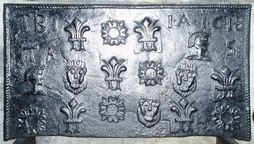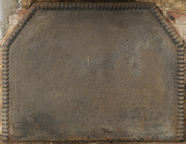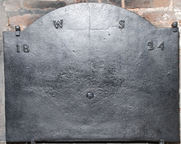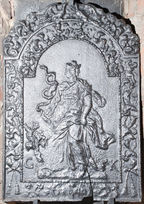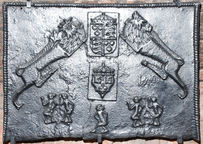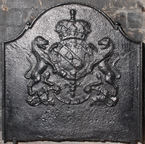-
190
Description: Arched rectangle; bevelled edge to arch and top of shoulders; initials at centre top of arch, in triangle 'S' at top; date below initials.
Notes: Possibly the work of David Robertson (1716-93), the King's Smith, whose iron grates are commonly to be found in houses designed by the prominent Scottish architects, Robert, John and James Adam, of whom he was a kinsman; the form of the plate is typical of grate-backs Robertson made in a variety of sizes, notably at Dumfries House, Ayrshire, although the lack of evidence of fixings suggest that this may have been made to be free-standing. Until 1756/7 Robertson had his forge in a tenement in Niddery's Wynd, Edinburgh, between High Street and Cow Gate, next door to John Adam's premises, although it is not known if he had a foundry there.
Inscription: S / W A / 1745
- Decoration tags:
- rectangular with round arch (shape)
- individual letters
- individual numbers
- text
Manufactured: in 1745 possibly in the Edinburgh area of Scotland.
Current location: Hill Top, Sawrey, Hawkshead, Hawkshead, Cumbria, England.
Museum number: 641831 (part of the National Trust museum group)
- Attached to series:
- Date & initials firebacks
-
191
Description: Arched rectangle; cavetto moulded edging; Tudor royal shield, Garter and crown, with crowned lion and dragon supporters; motto along bottom; Tudor rose to left of crown, portcullis to right.
Notes: This painted fireback is reputed to have been a gift from King Henry VIII to the second Sir William Godolphin, who was present at the Siege of Boulogne in 1544 with a party of Godolphin tin miners.
Copies of this fireback are known.
Inscription: HONI SOIT QVI MAL E PENSE / DIEU ET MON DROIT
Arms: Tudor royal (Elizabeth I)
- Decoration tags:
- rectangular with round arch (shape)
- cavetto (edging)
- whole carved pattern
- armorial
- text
Manufactured: in the mid- to late-16th century possibly in the Weald area of England.
Current location: Godolphin House, Helston, Cornwall, England.
Museum number: 169480 (part of the National Trust museum group)
- Attached to series:
- Tudor royal armorial firebacks
-
192
Description: Rectangular; twisted rope edging (top and sides); irregular arrangement of four stamps in three rows: face mask with ?crown and ruff (3), flower head with four petals and leaflets (4), fleur de lys (5), and profile of a head with 'Roman' crest (2); initials replace stamps in top corners.
Notes: A larger variant, undated and with other initials but the same four stamps, is also known.
Inscription: TBI I•A•1•6•1•8 / TA S
- Decoration tags:
- rectangular (shape)
- rope (edging)
- carved stamps
- individual letters
- individual numbers
- heraldic
- text
- humans
- plants
Manufactured: in 1618 possibly in the Weald area of England.
Current location: Godolphin House, Helston, Cornwall, England.
Museum number: 169481 (part of the National Trust museum group)
- Attached to series:
- Primitive stamp series
-
323
Description: Canted rectangle; simulated rope edging; otherwise plain.
Copies of this fireback are known.
- Decoration tags:
- rectangular with canted top corners (shape)
- simulated rope (edging)
- whole carved pattern
Manufactured: in the mid-20th century in England.
Current location: Hardy's Cottage, Higher Bockhampton, Dorset, England.
Museum number: 426390 (part of the National Trust museum group)
- Attached to series:
- Base boards
-
1271
Description: Rectangular shape; twisted rope edging (top and sides only); central initials, WS, in different character sets, between split date, also in different numeral sets, with a rectangular floral patera repeated at each end; below, and at a slight incline to the right, a horizontal twisted rope dividing the plate. The '5' of the date has been stamped in reverse.
Notes: A boldly cast fireback with disparate character styles. Probably acquired for the castle in the early-20th century during its refurbishment for Edward Hudson by Edwin Lutyens.
Inscription: 1 6 W S 7 5 [5 reversed]
- Decoration tags:
- rectangular (shape)
- rope (edging)
- simple stamps
- carved stamps
- individual letters
- individual numbers
- text
- plants
Manufactured: in 1675 in England.
Current location: Lindisfarne Castle, Holy Island, Northumberland, England.
Museum number: 511616 (part of the National Trust museum group)
- Attached to series:
- Date & initials firebacks
- Miscellaneous stamp firebacks
-
347
Description: Rectangular; twisted rope edging (top and sides); central Tudor shield, garter, crown and supporters (greyhound and lion), formed from separate stamps; date on a single stamp in top left corner.
Notes: The worn appearance of the central arms, compared with the clarity of the date, suggests that this is an early example of a fireback being used as a pattern, with the addition of a subsequent date. The same stamps forming the arms can also be seen on other firebacks. The extension of the lower part of the ‘3’ on the date stamp suggests that the numbers may have been fixed to the backing block, rather than the date being carved as a whole. Another variant of this fireback has the rope edging extending only three-quarters of the way down the sides.
Inscription: 1583
Arms: Tudor royal
- Decoration tags:
- rectangular (shape)
- rope (edging)
- carved stamps
- date stamp
- armorial
- royal
- text
Manufactured: in 1583 in the Weald area of England.
Current location: Ightham Mote, Ightham, Kent, England.
Museum number: 825358 (part of the National Trust museum group)
- Attached to series:
- Pounsley series
- Tudor royal armorial firebacks
- Tudor redated series
-
343
Description: Arched rectangular shape; no edging; initials evenly spaced around arch; date split between top corners.
Inscription: W S / 18 24
- Decoration tags:
- rectangular with round arch (shape)
- none (edging)
- individual letters
- individual numbers
- text
Manufactured: in 1824 in England.
Current location: Ightham Mote, Ightham, Kent, England.
Museum number: 825375 (part of the National Trust museum group)
- Attached to series:
- Date & initials firebacks
-
344
Description: Arched rectangular central panel, with bead-and-pellet edging; pictorial, standing female figure in classical dress, facing to the left, holding a snake in her right hand, a bunch of flowers at lower left; the initials located in bottom corners; arched rectangular border, fillet edging, containing swirled foliage, with a putto in the top corners; on top, two perched bird facing each other, with swirled foliage descending behind them.
Notes: The figure is of Sapientia, or Wisdom, based closely on an engraving, one of a set entitled 'The Virtues' by Hendrik Goltzius c.1593; a small number of firebacks bear the initials, GK; it is not known to whom they refer, but dated ones are of 1700.
Copies of this fireback are known.
Inscription: G K
- Decoration tags:
- 'Dutch' (shape)
- fillet (edging)
- whole carved pattern
- pictorial
- allegorical
- text
- humans
Manufactured: in the early-18th century in the Siegerland area of Germany.
Current location: Ightham Mote, Ightham, Kent, England.
Museum number: 825381 (part of the National Trust museum group)
- Attached to series:
- 'Dutch' GK series
-
345
Description: Rectangular; twisted rope edging (top and sides); from top, crowned Tudor royal shield (stamp overpressed) above crowned shield bearing initials, KH in Lombardic lettering, above a fleur de lys (stamp overpressed); to left, diagonal lion passant guardant sinister; to right, diagonal lion passant; at base, single 'imp' figure, arms to side, moving left but facing right, between two pairs of 'imp' figures (separately stamped), one moving left, right arm raised, the other moving right, right arm raised.
Notes: One of the 'Royal' series.
Arms: Tudor royal arms of England
- Decoration tags:
- rectangular (shape)
- rope (edging)
- carved stamps
- heraldic
- armorial
- animals
- humans
Manufactured: in the mid-16th century in the Weald area of England.
Current location: Ightham Mote, Ightham, Kent, England.
Museum number: 825393 (part of the National Trust museum group)
- Attached to series:
- Royal series
-
346
Description: Rectangular with arched rectangular shaped top joined by cavetto curves; astragal edging; shield, supporters, ducal coronet, motto and garter of the Duke of Dorset: Quarterly, Or and gules, a bend vair.
Notes: Almost certainly the arms of Lionel Sackville KG (1688-1765), created first duke of Dorset in 1720.
Copies of this fireback are known.
Inscription: [around shield] HONY SOIT QUI MAL Y PENSE / [on motto scroll] AUT NUNQUAM TENTES, AUT PERFICE
Arms: Lionel Sackville, 1st Duke of Dorset
- Decoration tags:
- rectangular with canted top corners and round arch (shape)
- astragal (edging)
- carved pattern panels
- text
Manufactured: in the early-18th century in the Weald area of England.
Current location: Ightham Mote, Ightham, Kent, England.
Museum number: 825513 (part of the National Trust museum group)
- Attached to series:
- Dorset arms series
- Personal armorial firebacks
- Sackville firebacks


